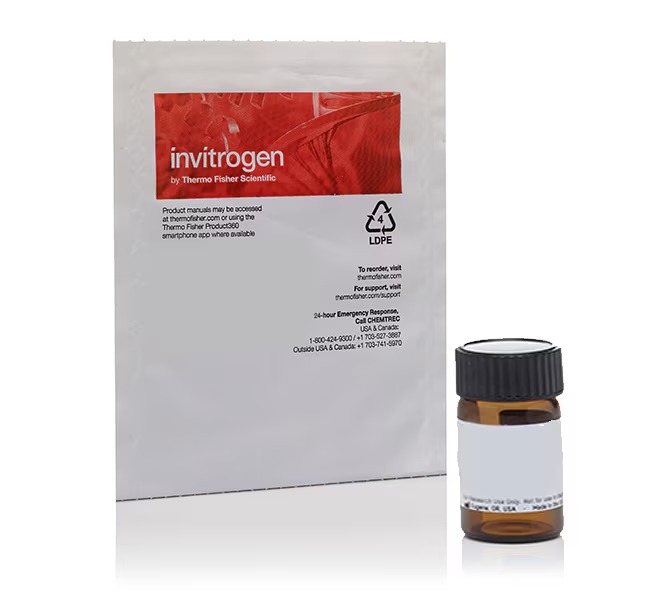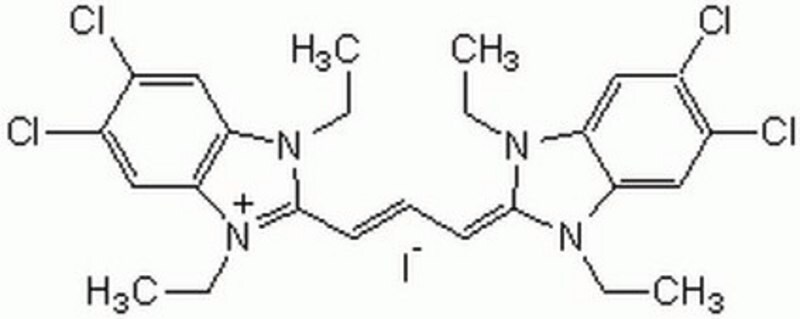Invitrogen™ JC-1 Dye (Mitochondrial Membrane Potential Probe), 5mg
Catalog No :
CAS Number :
Brand :
In Stock
Specifications:
| Application | Nucleic Acid Labeling and Detection | ||
| Storage Temperature | Room Temperature | ||
| Product Type | Dye | Forms | Powder |
| Product Brand | Thermo Fisher Scientific™, Invitrogen | ||
| Product Grade | Molecular Biology | Formula | C₂₅H₂₇Cl₄IN₄ |
The JC-1 Dye is a novel cationic carbocyanine dye designed to measure the mitochondrial membrane potential in live cells. The dye exhibits two distinct fluorescence emissions: as a monomer, it emits green fluorescence at low concentrations, similar to fluorescein. At higher concentrations, the dye aggregates into J-aggregates, producing a red fluorescence with an emission peak around 590 nm. This behavior makes JC-1 a sensitive and reliable marker for detecting changes in the mitochondrial membrane potential (ΔΨm).
JC-1 dye is used in live cells with active mitochondria and is not compatible with fixed cell staining. This dye provides an effective way to study mitochondrial function and can be used with fluorescence microscopes or flow cytometers.
Key Features:
-
Dual Fluorescence Emission:
- Green fluorescence for monomer form (low concentration) and red fluorescence for J-aggregates (higher concentration), allowing dual-channel imaging for mitochondrial membrane potential.
-
Sensitive Mitochondrial Membrane Potential Indicator:
- JC-1 dye is highly sensitive and specific to changes in the mitochondrial membrane potential, making it ideal for studying mitochondrial health, function, and dysfunction.
-
For Use in Live Cells:
- Optimized for live-cell imaging where active mitochondria are present. The dye is designed for in vivo staining, not for fixed cells.
-
Compatible with Fluorescence Microscopes and Flow Cytometers:
- The dye can be used with a fluorescence microscope for microscopic visualization of mitochondrial function or with a flow cytometer for quantitative analysis of large sample populations.
-
Room Temperature Storage:
- The dye can be stored at room temperature, making it convenient and easy to handle in routine laboratory work.
Specifications:
| Feature | Details |
|---|---|
| Color | Green (monomer) and Red (J-aggregate) |
| Detection Method | Fluorescence |
| For Use With (Equipment) | Fluorescence Microscope, Flow Cytometer |
| Product Type | Dye |
| Quantity | 5 mg |
| Shipping Condition | Room Temperature |
| Sub Cellular Localization | Mitochondria |
| Unit Size | 5 mg |
| Storage | Store at room temperature, protect from light |
Applications:
-
Mitochondrial Function Studies:
- Used to study mitochondrial health and dysfunction in cell biology and biomedical research. JC-1 dye provides critical insight into the mitochondrial membrane potential (ΔΨm) during cellular processes such as apoptosis, oxidative stress, and metabolic activity.
-
Cell Health Monitoring:
- Helps researchers monitor cell viability and mitochondrial health, aiding in the understanding of cellular energy production and the role of mitochondria in health and disease.
-
Apoptosis Research:
- Used to assess mitochondrial membrane potential changes as an early indicator of apoptosis (programmed cell death) in cancer research, drug development, and toxicology studies.
-
Metabolic Research:
- Important for studying metabolic shifts in cells, as mitochondrial membrane potential is closely linked to cellular energy metabolism.
-
Drug Testing:
- JC-1 dye is used to evaluate drug effects on mitochondrial function, enabling the identification of compounds that affect mitochondrial activity.
Storage:
- Store at room temperature and protect from light to ensure stability and accuracy in measurements.
The Invitrogen™ JC-1 Dye is an excellent mitochondrial membrane potential probe that provides sensitive and accurate measurements of mitochondrial function in live cells. With its ability to switch between green and red fluorescence, it offers a versatile and non-invasive tool for cellular research, drug development, and biomedical studies. Whether used in microscopy or flow cytometry, JC-1 enables researchers to monitor mitochondrial health, making it invaluable for studies in apoptosis, metabolism, and cell viability.




 0
0



